ADDING LENGTH & DEPTH
Next in 1937 Disney evolved the feature-length animated movie during which audiences could explore and savor for nearly an hour-and-a-half a completely fabricated environment as background for an elaborate story: Snow White and the Seven Dwarfs. A significant part of this particular environment for example was the dwarfs’ cottage nestled deep in a forest. In the classic style pioneered by the renowned Arthur Rackham (1867-1939) during the pre-World War I “Golden Age” of British storybook illustration Disney’s inspirational sketch artist Albrecht Hurter (1883-1942) set down to work:
…he had so many drawings of the stairs, the beds, the windows, the fireplace and even the kitchen sink, that the whole structure could be visualized.[1]
And not just visualized, but modeled as well. Ken Anderson (1909-1993) was recruited out of the Story Department to build a replica – one inch to the foot – based on Hurter’s sketches and complete with miniature furniture. An invaluable tool for layout and background artists as well as the animators themselves this model helped everybody to determine camera angles and consistently to orient spectators within the cottage’s interior. The sense of architectural space that resulted was precursor to similar feelings of familiarity with interiors in Pinocchio, Cinderella, Lady and the Tramp and Sleeping Beauty. It lent detailed visual credibility to each story’s environment and bolstered that suspension of disbelief so crucial to immersion in its alternate reality.
To make illusion even more compelling Disney green-lighted the construction and use of the multiplane camera which filmed scenes through numerous layers of painted glass and lent an all-new sensation of depth to the scenery as well as extraordinarily realistic rendering of water effects. Not only did this camera itself win an Academy-Award but another such award was granted to the “Silly Symphony” in which its capabilities were tested, The Old Mill (1937). This stunningly beautiful short climaxes in what can only be described as the rape of the title character by a violent storm including ripping off its “garments” immediately before its “penetration” (and dismemberment) by a lightning bolt. Afterward it stands eerily transfigured and ephemeral in the coming dawn. Snow White was nearly “in the can” when these multiplane experiments concluded so their effects are not as pervasive in that film as in Disney’s next feature Pinocchio wherein they are everywhere wondrously on display.

Then in 1940 came Fantasia – referred to as “The Concert Feature” during its production. Conducted by world-renowned maestro Leopold Stokowski (1882-1977) longtime impresario of the Philadelphia Orchestra Fantasia’s dazzling classical score was engineered in multi-track sound for the first time ever in the history of cinema. And this a mere dozen years after the very first co-ordination of any sound at all with the onscreen image! Walt dubbed it “Fantasound”. (The Soundtrack even makes an amusing appearance as an onscreen character!)
Sitting at the console tweaking and mixing his 9-track optical recording of the orchestra’s individual instrumental “choruses” Stokowski himself declared that Fantasound was the ultimate refinement in conducting. For its initial “roadshow” reserved-seating release Disney required that theaters booking to show Fantasia must install surround speakers – three big sound horns behind the screen and 65 smaller loudspeakers alongside and behind spectators. Apparently as originally conceived the instrumental sounds were recorded in such a way that they would appear to travel around the theater and screen co-ordinated with the movements of the characters inspired by them.
Thus, when a muted horn in Rite of Spring heralds the approach of Tyrannosaurus Rex, the horn sounds from the auditorium, far from the screen. As the monster comes closer to the screen, so does the horn call. When he crashes into the clearing, there is a crashing dissonance issuing from the very point on the screen where he appears.[2]
To further the audience’s immersion in his phantasmagoria Disney even toyed with the idea of providing spectators with polarized glasses so they might watch in 3D the introductory sequence Bach’s Toccata and Fugue in d minor. Also he considered wafting appropriate floral aromas at them during the Nutcracker Ballet section and gunpowder smoke during the magician’s conjuring at the beginning of The Sorcerer’s Apprentice. Additionally he wanted the projected image to be twice as wide as the then-standard 35mm, a goal he actually accomplished two decades later in The Sleeping Beauty. Some theaters acquiesced at least to the aural requirements which cost between $30,000 and $80,000 to install but that expense was too great for most. Instead after its initial release the film was pared down for mass consumption. Fortunately – once theater technology and political correctness caught up! – for subsequent theatrical release and later on to sell for home-viewing Fantasia was restored to its original version but with two exceptions: the movement of individual instrumental sounds all over the room and screen and the excision of a stereotypical racist portrayal of a couple Afro centaurettes (much more coming in my Fantasia blogs).
[1] Johnston, Ollie, and Thomas, Frank: op. cit., p. 244.
[2] Culhane, John: op. cit., p. 20.
